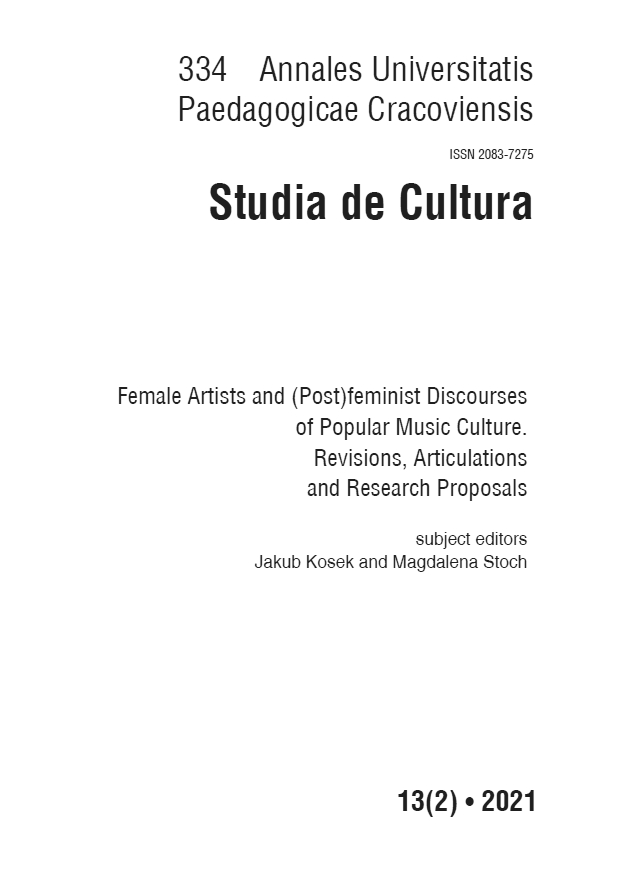Abstrakt
W niniejszym artykule chcę zaprezentować właściwości trans(ludzkich) głosów Cher i Anohni. Obie piosenkarki reprezentują niejednoznaczne i queerowe formy kobiecości, która denaturalizuje pojęcie płci oraz wikła odbiorcę w transgresywne doświadczenie estetyczne. Przy użyciu metafory cyborga zaproponowanej przez Donnę Haraway oraz koncepcji ziarna głosu Rolanda Barthesa chcę pokazać, jak kobiecy głos może stać się krytyczną formą oporu wobec patriarchalnej i mizoginistycznej koncepcji kobiecości.
Bibliografia
Auner Joseph. 2003. “Sing it for Me: Posthuman Ventriloquism in Recent Popular Music”. Journal of the Royal Musical Association no. 128.1. 98–122.
Zobacz w Google Scholar
Auslander Philip. 2008. Liveness: Performance in a Mediatized Culture. Routledge. London, New York.
Zobacz w Google Scholar
Bakke Monika. 2010. Bio-transfiguracje: sztuka i estetyka posthumanizmu. Poznań.
Zobacz w Google Scholar
Barthes Roland. 1977. Image Music Text. Stephen Heath (transl.). New York.
Zobacz w Google Scholar
Butler Judith. 1996. “Burning Acts: Injurious speech”. U. Chi. L. Sch. Roundtable. vol. 3.
Zobacz w Google Scholar
Cadilhe, Orquídea. 2016. “Cher’s Music Videos. Gender as a Performative Construction”. CECS-Publicações/eBooks. 103–121.
Zobacz w Google Scholar
Cusick Suzanne G. 1999. Gender, Musicology, and Feminism. In: Rethinking Music. Nicholas Cook and Mark Everist (eds.). Oxford. 471–98.
Zobacz w Google Scholar
Dickinson Kay. 2001. “Believe’? Vocoders, Digitalised Female Identity and Camp”. Popular Music no. 20.3. 333–347.
Zobacz w Google Scholar
Dunsby Jonathan. 2009. “Roland Barthes and the Grain of Panzéra’s Voice”. Journal of the Royal Musical Association no. 134.1. 113–132.
Zobacz w Google Scholar
Goldin-Perschbacher Shana. 2008. Sexuality, Listening, and Intimacy: Gender Transgression in Popular Music, 1993–2008. ProQuest.
Zobacz w Google Scholar
Halberstam J. Jack and Judith Halberstam. 2005. In a queer time and place: Transgender Bodies, Subcultural Lives: 3. New York.
Zobacz w Google Scholar
Halberstam Jack. 2017. Trans: A Quick and Quirky Account of Gender Variability. Vol. 3. California.
Zobacz w Google Scholar
Haraway Donna. 2006. A Cyborg Manifesto: Science, Technology, and Socialist-Feminism in the Late Twentieth Century. In: The Transgender Studies Reader. Susan Stryker and Stephen Whittle (eds.). New York, London. 103–119.
Zobacz w Google Scholar
Hayles N. Katherine. 2008. How We Became Posthuman: Virtual Bodies in Cybernetics, Literature, and Informatics. Chicago.
Zobacz w Google Scholar
Knapik Rozalia. 2015. Sztuczny Bóg. Kulturowe wizerunki Osobliwości. Poznań.
Zobacz w Google Scholar
Loza Susana. 2001. “Sampling (hetero) sexuality: diva-ness and discipline in electronic dance music”. Popular Music no. 20.3. 349–357.
Zobacz w Google Scholar
More Max. 2003. Principles of Extropy. Extropy Institute. http://www.extropy.org (access: 13.10.2020).
Zobacz w Google Scholar
Muñoz José. 2009. Cruising Utopia: The There and Then of Queer Theory. New York.
Zobacz w Google Scholar
Preciado Beatriz. 2013. Testo Junkie: Sex, Drugs, and Biopolitics in the Pharmacopornographic Era. The Feminist Press at CUNY. New York.
Zobacz w Google Scholar
Reynolds Simon. 2018. How Auto-Tune Revolutionized the Sound of Popular Music. Pitchfork. https://pitchfork.com/features/article/how-auto-tune-revolutionizedthe-sound-of-popular-music/(access: 13.10.2020).
Zobacz w Google Scholar
Stryker Susan. 1998. “The Transgender Issue: An introduction”. GLQ: A Journal of Lesbian and Gay Studies no. 4(2). 145–158.
Zobacz w Google Scholar
Sullivan Nikki. Transmogrification: (Un) Becoming Other. In: The Transgender Studies Reader. Susan Stryker and Stephen Whittle (eds.). New York, London. 552–564.
Zobacz w Google Scholar
Tawa Nicholas E. 1990. The Way to Tin Pan Alley: American Popular Song, 1866–1910. New York.
Zobacz w Google Scholar
Wilson Carl. 2014. Let’s Talk About Love: Why Other People Have Such Bad Taste. New York.
Zobacz w Google Scholar

Utwór dostępny jest na licencji Creative Commons Uznanie autorstwa – Użycie niekomercyjne 4.0 Międzynarodowe.

